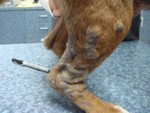|
Canine Lick Granuloma
Lick Granulomas - skin lesions created by licking

Comprehensive Information Sheet on Lick Granulomas in Dogs
Lick granulomas, medically termed as acral lick dermatitis, are a challenging and recurrent condition seen in dogs that involve excessive licking of a limb, leading to significant skin damage. This detailed information sheet will cover aspects such as the appearance, potential causes, differential diagnoses, diagnostic processes, and comprehensive treatment options for lick granulomas.
Appearance
- Lesion Characteristics: The primary sign of a lick granuloma is a well-demarcated, raised, and thickened lesion that is often hairless and ulcerated. The affected area is usually red, may be oozing, and can bleed when agitated. Chronic lesions can become hardened and hyperpigmented due to ongoing inflammation.
- Common Locations: Most commonly seen on the front part of the lower limbs, but can appear anywhere the dog can reach and persistently lick.
- Behavioral Indicators: Dogs with this condition often engage in compulsive licking of the same spot, which can be a clue to the underlying issue.
Causes
The development of lick granulomas is typically attributed to a combination of psychological and physical factors:
- Psychological Factors: Stress, anxiety, boredom, and obsessive-compulsive behaviors are significant contributors. These behaviors may stem from changes in the dog's environment, lack of exercise, or separation anxiety.
- Physical Factors: Conditions such as arthritis, neuropathy, or any painful process can initiate a cycle of licking that leads to skin trauma. Allergic skin disease and infections can also incite and perpetuate the behavior.
- Skin Infections: Secondary bacterial and fungal infections can exacerbate the skin's condition, increasing the dog's need to lick the area.
Differential Diagnoses
Differentiating lick granulomas from other dermatological conditions is crucial for effective treatment:
- Hot Spots (Acute Moist Dermatitis): These are acute, moist, and painful lesions that spread rapidly, unlike the more chronic and localized lick granulomas.
- Foreign Bodies: Embedded thorns or splinters can cause localized pain and licking but generally have a more acute onset.
- Neoplasia: Skin tumors may mimic the appearance of lick granulomas and should be ruled out through diagnostic testing.
- Fungal Infections: Conditions like ringworm can cause circular, itchy lesions that dogs may lick incessantly.
Diagnostic Process
A thorough diagnostic approach is vital to identify and treat the root cause of lick granulomas:
- Veterinary Examination: In-depth physical and dermatological exams to assess the nature and extent of the lesion.
- Complete Medical History: Detailed behavioral history including changes in the home environment, routine, and the onset of symptoms.
- Diagnostic Tests: These may include:
- Skin Scrapings: Checks for mites and fungal elements.
- Culture and Sensitivity: Identifies bacterial infections and appropriate antibiotics.
- Biopsy: Crucial for excluding cancerous conditions.
- Imaging Studies: Radiographs or ultrasounds to investigate underlying bone involvement or deeper soft tissue changes.
Treatment Options
Managing lick granulomas requires an integrative approach tailored to individual needs:
- Medical Treatments:
- Topical Agents: Includes corticosteroids to reduce inflammation and antibiotic ointments to treat infection.
- Systemic Therapies: Oral antibiotics, pain relievers, or anti-inflammatory drugs based on underlying causes.
- Psychotropic Medication: In cases of significant behavioral contribution, medications such as SSRIs or tricyclic antidepressants might be prescribed.
- Physical Barriers: Using an Elizabethan collar or protective boots to prevent access to the lesion.
- Advanced Therapies:
- Laser Therapy: Can aid in healing by reducing inflammation and promoting tissue regeneration.
- Behavioral Modification: Professional behavioral consultation to address compulsive licking, including increased mental and physical stimulation.
- Surgical Intervention: Reserved for severe cases where conservative management fails, involving excision of the affected tissue.
Prognosis and Management
Lick granulomas can be a persistently recurring issue, requiring ongoing management and adjustments in treatment strategies. Successful management hinges on a multifaceted approach that addresses both the physical and psychological aspects of the condition. Regular follow-ups with a veterinarian are essential to monitor progress and adapt treatments as necessary, aiming to improve the quality of life for affected dogs.
|